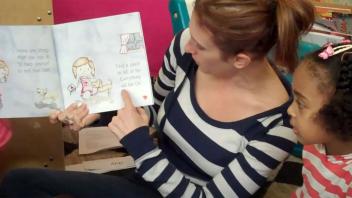What is concept of word?
Students with a strong concept of word recognize that spoken language is made up of distinct words and that these words are represented by spaces between written words. They understand that each spoken word corresponds to one written word. As students read, they match the words they say aloud to the words on the page in a one-to-one relationship.
Readers with a well-developed concept of word can visually track words on a page as they read. They move their eyes from left to right, recognizing each word individually.
Why teach concept of word?
Developing the concept of word is often part of emergent reading skills in the early grades. This skill is essential for young readers as they transition from recognizing individual letters and sounds to understanding how these elements come together to form words.
Key Information
Focus
When To Use This Strategy
Appropriate Group Size
Research suggests that only when a student can point to individual words accurately within a line of text will they be able to learn new words while reading. Incorporating concept of word instruction into daily literacy practice will not only strengthen students’ speech-to-print match, it will also develop students’ alphabet knowledge, phonemic awareness, and knowledge of words in print. See: Concept of Word in Text: An Integral Literacy Skill.
Concepts of print (print awareness)
“Concepts of print” is sometimes confused with concept of word. Both are foundational early literacy skills. Concepts of print includes an understanding that print carries meaning, that books contain letters, words, sentences, and spaces. It also includes understanding what books are used for, and that books have parts such as a front cover, back cover and a spine. Learn more:
How to teach concept of word
There are many effective activities for building the skills associated with concept of word in students from PreK to 3rd grade. A few of these activities are specifically described below.
Dictation with lines for writing
One of the simplest ways to develop a concept of word is to work individually with a child and a picture he or she has drawn. “Tell me about your picture!” As the student begins to talk, summarize what he has said in a few words or consider the child’s words as dictation. “The leaves are falling.” Draw one line for each word under the picture. Then help the child begin to write sounds for each different word in their dictation. Watch this activity in action
Be the sentence
Physical involvement and hands-on activities are great for increasing learning in young children. One activity to support concept of word learning is to have each student physically represent a word in a sentence that the teacher creates. Create single-page size cards for each student, with one word on each card (for example “We” “went” “to” “the” “store”). Students work together to arrange themselves into the proper order to form a sentence.
Cut-up sentence
This activity includes active learning about words as part of a sentence. Teachers prepare a sheet of simple sentences printed out with a large-size font. Students cut apart the words from a sentence, and then move the individual word cards around, manipulating the words to re-create the sentence in proper order. This helps encourage students to recognize that each word is a separate entity, has meaning, and is separated by a space within each sentence.
Unifix word
Teachers can show students how to build and rebuild sentences by connecting unifix cubes. Students can learn about concept of word as they grasp the understanding that each cube represents a word in the target sentence regardless of syllables within words. This activity includes the use of Unifix cubes (Amazon).
General activities
The Get Ready to Read site offers 36 activity cards for use with an individual child or a group of children, in English and in Spanish.
Word walls
See how word walls can be used to help students build their concept of word skills. The sites below provides tips on word choice as well as many examples of real-life classroom word walls.
- Examples from Reading Rockets
- Word Wall Activities and Resources (Education World)
- Building a Better Word Wall (Edutopia)
- Word Walls That Work (Scholastic)
More concept of word activities
Download this set of preK–grade 3 concept of word activities from the University of Virginia PALS program.
Watch a lesson on counting words (whole class)
Students identify words by circling them in the morning message written on the Smart Board. (Balanced Literacy Diet: Putting Research into Practice in the Classroom)
Watch a lesson on finger-pointing during a read-aloud (small group)
Watch a demonstration of counting words in sentences
In this activity, the teacher uses counters to help students identify how many words are in a sentence. (Teach for Life)
Watch a lesson: counting words in sentences using magnets (whole class)
In this sentence segmenting activity, the teacher works with students to count the words in sentences they generate using a magnet to represent each word. Notice that the activity is heavily scaffolded. With practice, the students will be able to segment sentences with increasingly less support. (Teach for Life)
Differentiate instruction
For second language learners, students of varying reading skill, and younger learners
- Use oral activities to help support students of lower level reading skills.
- Use activities that include pictures to support ESL students and younger students.
See the research that supports this strategy
Morris, D. (1981). Concept of word: A developmental phenomenon in the beginning reading and writing process. Language Arts, 58, 659-668.
Report of the National Reading Panel (NRP) (2000). Teaching children to read: An evidence-based assessment of scientific research literature on reading and its implications for reading instruction. Washington, DC: U.S. Department of Health and Human Services.
Roberts, E. (1992). The evolution of the young child’s concept of word as a unit of spoken and written language. Reading Research Quarterly, 27, 124-138.
